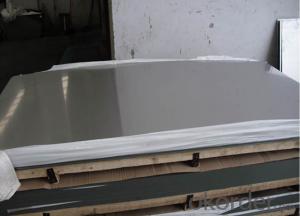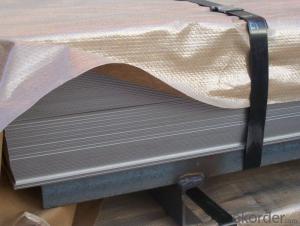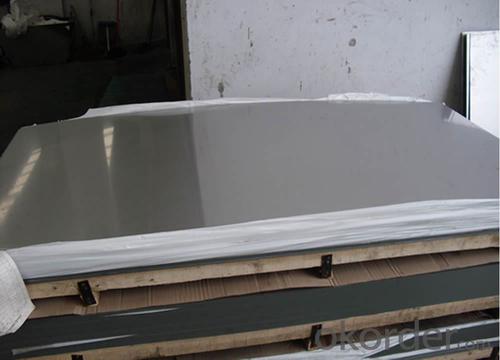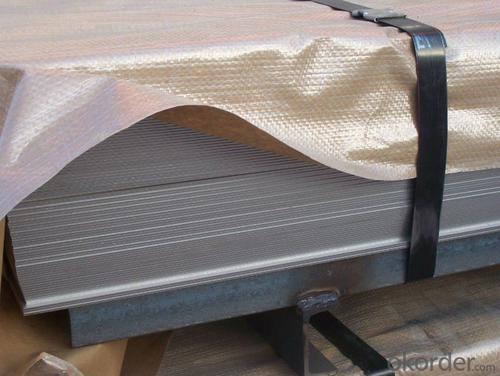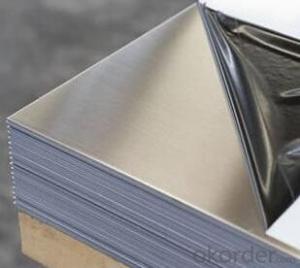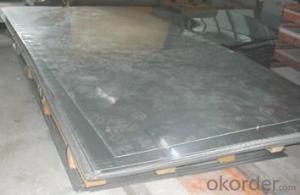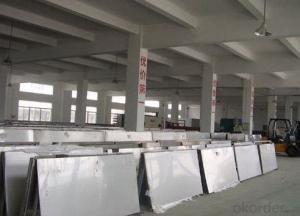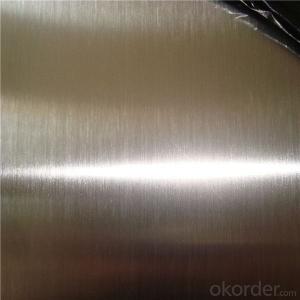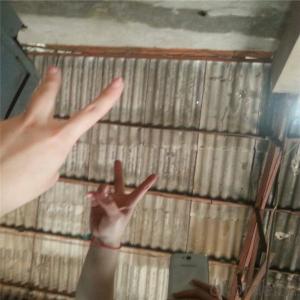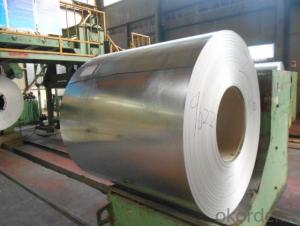Stainless Steel Sheet/Plate 309 High Temperature Resistance
- Loading Port:
- China main port
- Payment Terms:
- TT OR LC
- Min Order Qty:
- 50 m.t.
- Supply Capability:
- 10000 m.t./month
OKorder Service Pledge
OKorder Financial Service
You Might Also Like
Specification
Stainless Steel Sheet/Plate 309 with High Temperature Resistance
Description
304 stainless steel is the most widely used in the 300 series stainless steel. Its anti-corrosion property is stronger than the 200-series
stainless steel, but the anti-acid property is worse than 316. 304 stainless steel have a good resistance in high temperature and the
excellent corrosion resistance. 304 stainless steel is more expensive than 201, cheaper than the 316.
1. Commodity: 304 Stainless Steel
2. Technique: Cold Rolled/hot rolled Stainless Steel
3. Grade: 304 Stainless Steel
4. Type: Stainless Steel Sheet/coil
5. Finish: 2B/Ba/8K/Emboss/Etch
6. Edge: mill edge /silted edge
7.Size:1219mm*2438mm,1219mm*3048mm,or as customized
Main Features
•Escalator, Elevator, Doors
•Furniture
•Production tools, Kitchen appliances, freezers, cold rooms
•Auto Parts
•Machinery and Packaging
•Equipment and Medical devices
•Transport system
Specifications
Description | steel sheet,hot rolled steel sheet,cold rolled steel sheet, steel sheet,sheet,steel plate |
Standard | ASME, ASTM, EN ,BS,GB,DIN, JIS etc |
Application | Steel sheet applies to construction field, ships building industry, petroleum & chemical industries, war and electricity industries, food processing and medical industry, boiler heat exchanger, machinery and hardware fields. |
Surface Finish
Surface finish | Characteristics and application |
2B | The surface brightness and flatness of no2B is better than no2D. then through a special surface treatment to improve its mechanical properties,No2B could nearly satisfy comprehensive uses. |
No.1 | Polished with abrasive belt of grit#100-#200, have better brightness with discontinuous coarse stria, used as inner and external ornaments for building, electrical appliances and kitchen utensils etc. |
No.4 | Polished with abrasive belt of grit #150-#180,have better brightness with discontinuous coarse stria, but thinner than No3, are used as bathtub buildings inner and external ornaments electrical appliances kitchen utensils and food processing equipment etc. |
HL | Polished with abrasive belt of grit #150-#320 on the NO.4 finish and has continuous streaks, mainly used as buildings ornaments elevators, door of building, frontal plate etc. |
BA | Cold rolled, bright annealed and skin-passed, the product have excellent brightness and good reflexivity like mirror, kitchen apparatus, ornament etc. |
8K | The product have excellent brightness and prefer reflexivity can to be the mirror. |
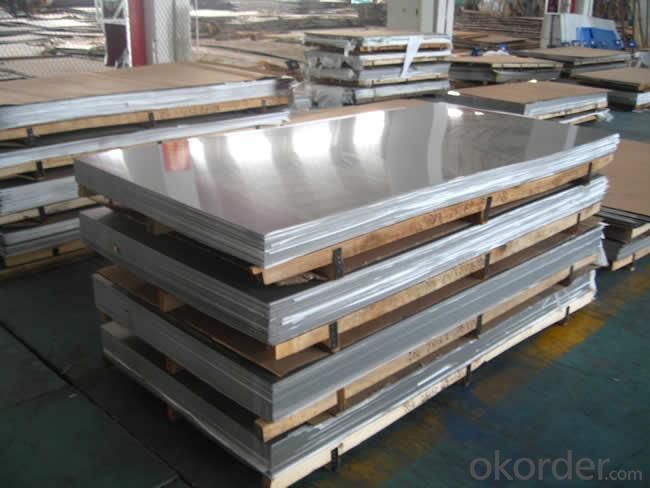
- Q: What is the minimum order quantity for stainless steel sheets?
- The minimum order quantity for stainless steel sheets may differ based on the supplier and the specific product. Nevertheless, it is typical for suppliers to impose a minimum order quantity between 1 and 10 sheets. To select the most suitable option for your requirements, it is crucial to reach out to multiple suppliers and inquire about their minimum order requirements.
- Q: What is the weight of a stainless steel sheet?
- The weight of a stainless steel sheet can vary depending on its dimensions and thickness. Stainless steel has a density of around 8 grams per cubic centimeter, so to calculate the weight of a sheet, you would need to know the length, width, and thickness of the sheet. By multiplying these dimensions together and then multiplying by the density, you can determine the weight of the stainless steel sheet. For example, a 4-foot by 8-foot stainless steel sheet with a thickness of 1/8 inch would weigh approximately 56 pounds. It is important to note that these calculations are approximate and may vary slightly depending on the exact composition and grade of the stainless steel.
- Q: What are the different thickness tolerances for stainless steel sheets?
- The thickness tolerances for stainless steel sheets can differ based on the specific grade and type of stainless steel used. In general, the industry standard tolerances for thinner sheets range from +/- 0.005 inches to +/- 0.010 inches, while for thicker sheets, the range is from +/- 0.010 inches to +/- 0.015 inches. These tolerances ensure that the thickness of the stainless steel sheets remains suitable for various applications in the construction, automotive, and manufacturing industries. However, it is important to note that the manufacturer or supplier, as well as the intended use of the stainless steel sheets, may cause specific tolerances to vary. Therefore, it is always recommended to refer to the relevant specifications provided by the manufacturer or supplier to determine the precise tolerances for a specific stainless steel sheet.
- Q: What is the elongation of stainless steel sheets?
- When stainless steel sheets are subjected to tensile forces, their ability to stretch or deform without breaking is known as elongation. This property is measured as a percentage of the original length of the sheet that can be stretched before it fractures. The elongation of stainless steel sheets can vary depending on the grade of stainless steel and the way it is manufactured. In general, stainless steel sheets have a higher elongation compared to metals like carbon steel because they are more ductile. However, the specific elongation value can vary based on factors such as the grade, thickness, and tempering of the stainless steel sheet.
- Q: Are stainless steel sheets suitable for elevator control panels?
- Yes, stainless steel sheets are suitable for elevator control panels. Stainless steel is a durable and resistant material that can withstand various environmental conditions, including frequent use and exposure to moisture, heat, and chemicals. Elevator control panels often require a material that is easy to clean, resistant to scratches and dents, and aesthetically pleasing. Stainless steel meets all these criteria, making it an ideal choice for elevator control panels. Additionally, stainless steel has a sleek and modern appearance, which can enhance the overall design of the elevator interior.
- Q: Are stainless steel sheets heat-resistant?
- Yes, stainless steel sheets are heat-resistant. Stainless steel is known for its ability to withstand high temperatures without warping or deforming, making it an excellent choice for applications that involve heat exposure. The chromium content in stainless steel forms a protective layer on the surface, which helps to prevent oxidation and corrosion even at elevated temperatures. This heat resistance property makes stainless steel sheets suitable for a wide range of applications, including industrial equipment, kitchen appliances, automotive parts, and construction materials.
- Q: What is the impact strength of stainless steel sheets?
- The impact strength of stainless steel sheets may vary based on several factors, including the grade and thickness of the stainless steel and the specific conditions under which the impact occurs. Stainless steel possesses inherent properties that contribute to its good level of impact strength, such as high tensile strength and ductility. Stainless steel is renowned for its ability to endure impacts and resist deformation, making it a favored material in industries where durability is crucial. It demonstrates exceptional resistance to impact loading, enabling it to withstand sudden impact forces without fracturing or breaking. Consequently, stainless steel sheets are well-suited for applications that demand high impact resistance, such as structural components, automotive parts, and machinery. Nevertheless, it is important to note that impact strengths may differ among various grades of stainless steel. Austenitic stainless steels (e.g., 304 and 316), for instance, exhibit excellent impact resistance due to their elevated nickel and chromium content. Conversely, ferritic and martensitic stainless steels may possess slightly lower impact strengths. Moreover, the thickness of the stainless steel sheet also influences its impact strength. Thicker sheets generally offer greater impact resistance compared to thinner ones, as they can absorb more energy before yielding or fracturing. It is worth mentioning that the impact strength of stainless steel can be further improved through additional methods, such as heat treatment and alloying. These processes enhance the material's toughness and resistance to impact loading. In conclusion, stainless steel sheets possess favorable impact strength that suits many applications. However, it is advisable to consult specific grade and thickness specifications, as well as any relevant industry standards or regulations, to determine the precise impact strength requirements for a particular application.
- Q: Are stainless steel sheets suitable for kitchen countertops?
- Yes, stainless steel sheets are highly suitable for kitchen countertops. They are durable, resistant to stains and corrosion, easy to clean, and provide a sleek and modern look to the kitchen.
- Q: What are the different shapes available for stainless steel sheets?
- Stainless steel sheets are available in various shapes, including flat sheets, perforated sheets, corrugated sheets, embossed sheets, and diamond plates. These shapes cater to different applications and aesthetic preferences in industries such as construction, automotive, and interior design.
- Q: What is the area of stainless steel plate?
- For example, a steel coil with known weight, thickness, length, width, and price, you can work out the cost price of each meter, and then you can set the price as you expect it
Send your message to us
Stainless Steel Sheet/Plate 309 High Temperature Resistance
- Loading Port:
- China main port
- Payment Terms:
- TT OR LC
- Min Order Qty:
- 50 m.t.
- Supply Capability:
- 10000 m.t./month
OKorder Service Pledge
OKorder Financial Service
Similar products
Hot products
Hot Searches
Related keywords
